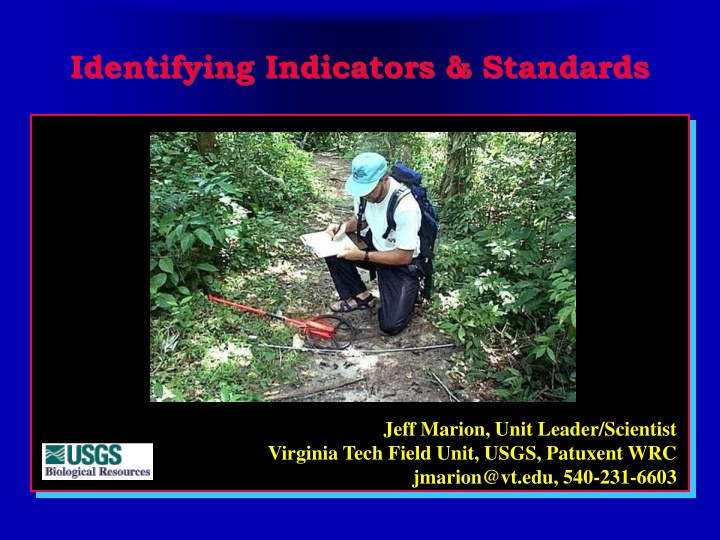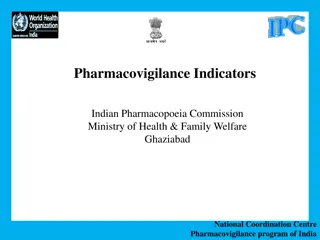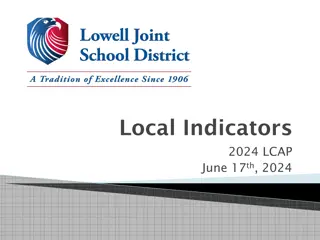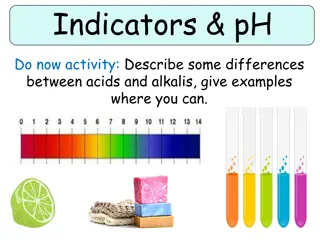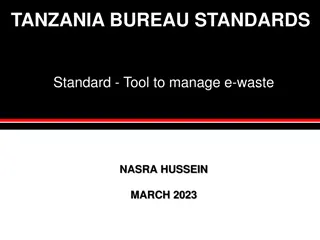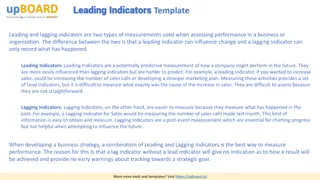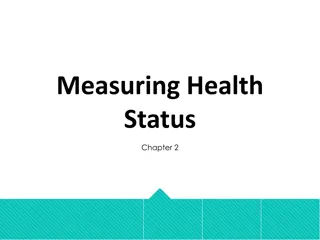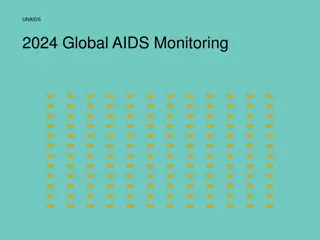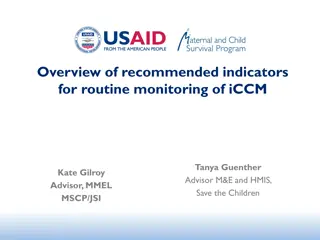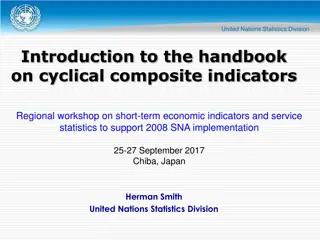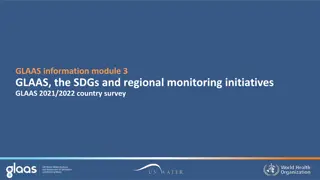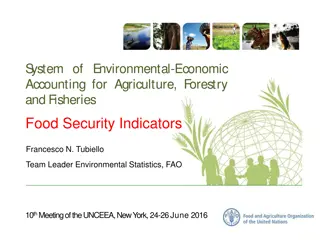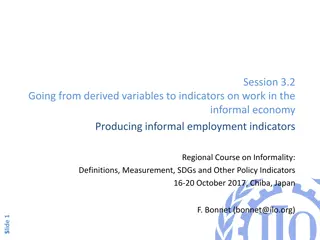Indicators and Standards in Environmental Management
Exploring the concept of indicators and standards in environmental management, this content delves into their definition, selection process, sources, and importance. Indicators are crucial variables used to track changes caused by human activities, aiding in assessing progress towards desired conditions. The selection of indicators involves defining monitoring questions and utilizing various sources such as scientific literature, research, stakeholder consultation, and management judgment. This information is essential for effective planning and decision-making in environmental conservation and management.
Download Presentation

Please find below an Image/Link to download the presentation.
The content on the website is provided AS IS for your information and personal use only. It may not be sold, licensed, or shared on other websites without obtaining consent from the author.If you encounter any issues during the download, it is possible that the publisher has removed the file from their server.
You are allowed to download the files provided on this website for personal or commercial use, subject to the condition that they are used lawfully. All files are the property of their respective owners.
The content on the website is provided AS IS for your information and personal use only. It may not be sold, licensed, or shared on other websites without obtaining consent from the author.
E N D
Presentation Transcript
Identifying Indicators & Standards Jeff Marion, Unit Leader/Scientist Virginia Tech Field Unit, USGS, Patuxent WRC jmarion@vt.edu, 540-231-6603
Selecting Indicators & Standards Presentation Objectives: 1. Define indicators and describe their role, review criteria for their selection, and illustrate with trail impact examples. 2. Define indicator standards and describe their role, describe alternative types of standards, and illustrate with trail and campsite examples.
LAC & VERP Planning And Management Decision Making Frameworks Establish Prescriptive Management Objectives Choose Biophysical and Social Indicators of Change Formulate Standards Monitor Conditions Compare Conditions to Standards Standards Not Exceeded Standards Exceeded Evaluate and Identify Causal Factors Select Appropriate Management Action Implement Management Action
What Are Indicators? What are indicators and why do we use them? Indicators are measurable physical, ecological, or social variables used to track trends in conditions caused by human activity so that progress toward goals / desired conditions can be assessed. Indicators provide a means for restricting information collection and analysis to the most essential elements needed to answer management questions.
Indicator Selection: A Process Begin by defining monitoring questions: Are visitors experiencing an environment where the evidence of human activity is substantially unnoticeable? Are trails in good usable condition? or, Are the number and length of visitor-created trails increasing?
Indicator Selection: Sources of Indicators Employ one or more of the following sources: Consult Scientific Literature:There is a large and growing body of applicable literature. Conduct Scientific Research: Conduct site-specific research or inventories where necessary to address information gaps. Consult the Public: Involve stakeholders. Apply Management Judgment: Consult with experienced managers, both local and distant.
Indicator Selection: Screening Questions Does the indicator tell you what you want to know? Is it ecologically or experientially meaningful? Is the indicator independent of environmental variation? Can the indicator be measured reliably? Is the indicator responsive to manage - ment action within a reasonable time frame?
Indicator Selection: Screening Questions Does the indicator act as an early warning, alerting you to deteriorating conditions before unacceptable change occurs? Can the indicator be measured with minimal impact to the resource or the visitor s experience? Can the indicator provide information worth the time and cost required?
Indicator Selection: Screening Criteria Primary Criteria Specific Objective Reliable and repeatable Related to visitor use Secondary Criteria Easy to train for monitoring Cost-effective Minimal variability Responds over a range of conditions Large sampling window Availability of baseline data Sensitive Resilient Low-impact Significant (Source: VERP Handbook, 1997)
Trail Indicators Selected from a review of the scientific and management literature. LAC/VERP frameworks typically include a small number of indicators, far fewer than those shown in the following lists. Indicator assessment/monitoring methods need to be considered during the indicator selection process.
Forms of Trail Impacts Informal trails (number, length, condition) Trail widening Soil erosion Trail muddiness
Trail Indicators Monitoring approaches must be considered in selecting indicators and setting standards. Two common types: Problem Assessment: Assess location and lineal extent of all occurrences of pre-defined tread impacts (e.g., eroded or muddy sections). Point Sampling: Assess tread conditions through individual measures of indicators at sampling points.
Trail Assessment Survey Types Problem Assessment Point Sampling
Common Trail Indicators Soil Erosion Cross Sectional Area (sq ft) PS Maximum Incision (in) PS Excessive Erosion (# ft/mi, lineal ft, % of trail length) PA I3 I1 I2 I4 I5 I6 T6 T4 T1 T2 T3 T5 PA - Problem Assessment, PS - Point Sampling
Common Trail Indicators Tread Muddiness Muddiness (% of tread width) PS Excessive Muddiness (# ft/mi, lineal ft, % of trail length) PA Tread Width Tread Width (ft) PS Excessive Width (# ft/mi, lineal ft, % of trail length) PA PA - Problem Assessment, PS - Point Sampling
Common Trail Indicators Multiple Treads Multiple Treads (# at sample points) PS Multiple Treads (# ft/mi, lineal ft, %) PA Visitor-Created Trails Informal Trails (#, #/mi, lineal extent, % of formal trail miles) Other concerns related to informal trails: density, proximity to sensitive resources, and condition PA - Problem Assessment, PS - Point Sampling
What Are Indicator Standards? What are indicator standards and why do we use them? Indicator Standards - Measurable statements that define minimally acceptable conditions. Standards narrow the focus of management from broad, qualitative statements of management intent to specific statements of desired conditions that provide a basis for decision making.
What Are Indicator Standards? Standards reflect desired conditions. Standards: Are specific and achievable. Describe ends (desired resource and social conditions) rather than means (management actions). Standards are established for setting attributes that reflect degree of naturalness or that influence experience quality. Setting attributes must be subject to management control. For example, a standard could be written for encounter rates but not for solitude or satisfaction, which are direct attributes of the experience.
What Are Indicator Standards? Standards quantitatively specify a limit on the amount of change that will be tolerated. Standards define the compromise between resource/visitor experience protection and access to recreational opportunities, i.e., they represent an explicit trade-off between two conflicting goals. Standards are statements of minimally acceptable conditions (thresholds of acceptability). They define the point past which conditions become unacceptable, they do not define desired or unacceptable conditions.
Characteristics of Good Standards Quantitative: Measurable. Time or Space-Bounded: Expressed as x /day or y /unit area. Expressed as a probability: Allows flexibility when needed for random or peak-use events. Impact-Oriented: Focus on impacts, not on management actions (e.g., conditions, not # of visitors) Realistic: Focus on attainable conditions.
Interpreting Standards Standards are absolute limits, not just warnings. Violation of standards should not be tolerated. Tolerances can be written into standards in the form of probabilities. e.g., <10 encounters/day on 90% of the summer use season days. Such standards allow for more crowded conditions during a few peak use weekends. When a standard is exceeded managers should implement actions to avoid compromising resource or experience conditions further.
Interpreting Standards Standards are value-based management decisions. Setting standards ultimately involves inherently subjective and value-based management decisions. It is desirable that standards be developed through a collaborative process with input from stakeholders. Public involvement and/or participation is preferred but managers have been delegated the authority and responsibility for making final decisions.
Setting Standards: Role of Science Science can characterize the range of indicator conditions to allow evaluation of draft standards. Indicator data may also be examined to look for thresholds : e.g., level of vegetation disturbance beyond which annual recovery cannot occur. Standards can be informed by science but cannot be derived from science. Standards are evaluative, they must consider resource impacts in the context of the recreational costs of not exceeding them.
Types of Standards Maximum Condition - Specifies maximum acceptable indicator value at a single site. e.g., trail width < 10 in Aggregate Condition - Specifies maximum acceptable aggregate indicator value for a group of sites. e.g., Sum of informal trail lengths in travel zone x < 3.5 mi Rate of Change - Specifies maximum acceptable rate of change between monitoring cycles. e.g., increase in trail incision < 0.25 in/yr
Examples of Standards: Trails Potential Indicators Informal trails/unit area Increase in informal trail lengths < 100% Trail width Trail width >3 ft Soil erosion Soil erosion > 2 ft Trail muddiness Note: Standards are generally set and vary by zones. Examples of Standards <2500 ft/5 acres <4 ft <500 ft/mi <2 ft <300 ft/mi <5% of trail length
Examples of Standards: Campsites Potential Indicators Campsites/unit area Campsite size/site Campsite size/unit area Increase in campsite size Soil exposure/site Soil exposure/unit area Tree damage Fire sites Note: Standards are generally set and vary by zones. Examples of Standards <12 sites/5 acres <1800 ft2 <8000 ft2/5 acres < 100% <1200 ft2/campsite <6000 ft2/5 acres <10 damaged trees/site <3/site
Conclusions Scientific literature and research can help identify alternative resource indicators and provide objective measurement methods Scientific surveys can describe the distribution of values for each indicator illustrating outcomes of alternative standards. Science cannot be used to identify indicator standards. Standards are evaluative, they represent tradeoffs between competing management objectives.
